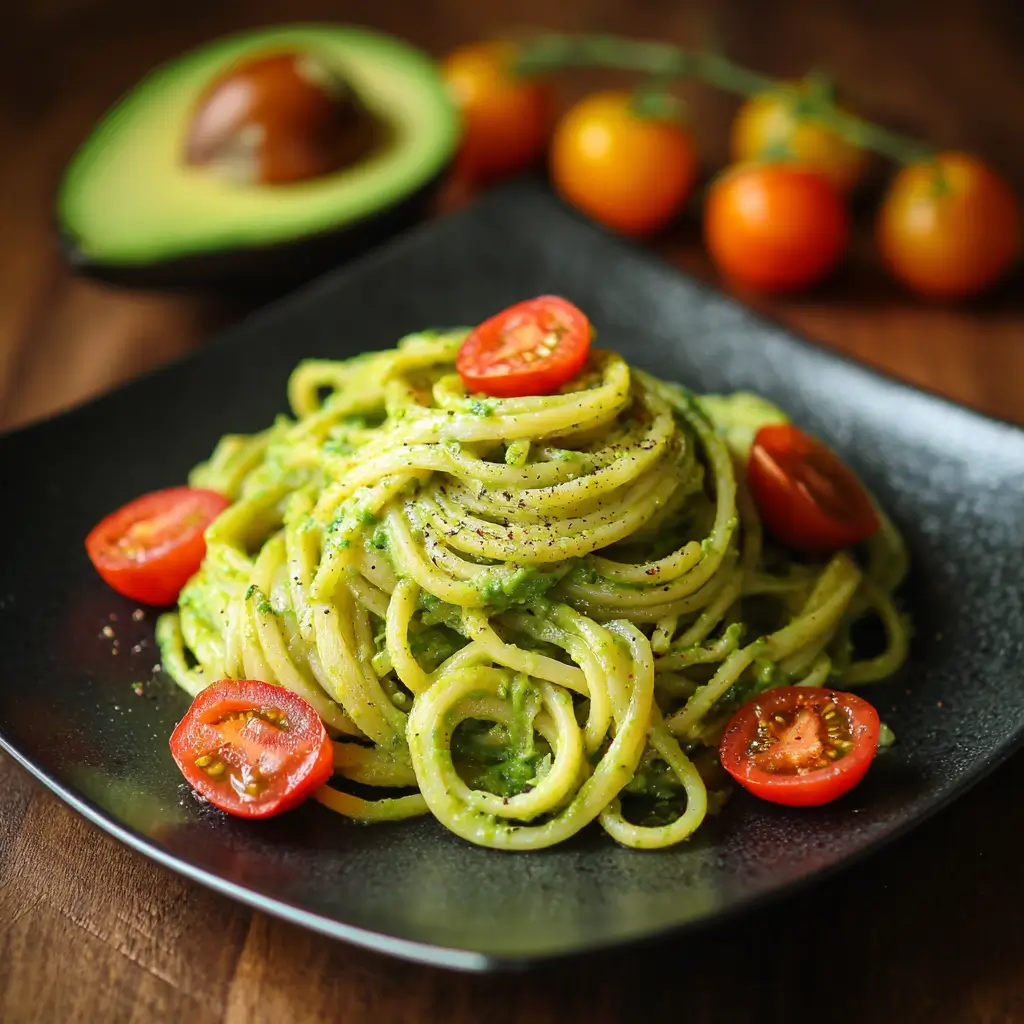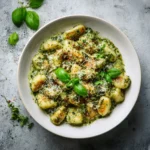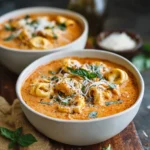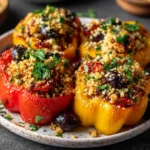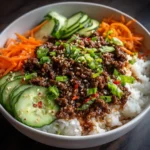Avocado Pesto Pasta: A Creamy, Fresh Twist on a Classic Italian Favorite
The world of pasta is vast and endlessly creative, but few dishes strike the perfect balance between richness, freshness, and simplicity quite like Avocado Pesto Pasta. This modern twist on traditional pesto swaps out some or all of the pine nuts and basil with ripe avocado, bringing a luscious creaminess and vibrant green hue to the dish. Whether you’re looking for a quick weeknight dinner, a meal-prep-friendly lunch, or a show-stopping dish for guests, this recipe delivers bold flavor with minimal effort. Packed with healthy fats, vibrant herbs, and al dente pasta, Avocado Pesto Pasta bridges the gap between Italian tradition and contemporary wellness cuisine.
The History of Pesto and Its Evolution into Avocado Pesto Pasta
Pesto originates from Genoa, in the Liguria region of Italy, where the classic pesto alla genovese has been made for centuries using fresh basil, garlic, pine nuts, Parmesan cheese, olive oil, and salt, traditionally ground together in a marble mortar with a wooden pestle. The word “pesto” actually comes from the Italian verb pestare, meaning “to crush or pound,” highlighting the labor-intensive method used to create the emulsified sauce.
As global palates evolved and ingredients became more accessible, variations of pesto began to emerge. Sun-dried tomato pesto, arugula pesto, and even kale-based versions gained popularity. Enter the avocado—a fruit native to Central and South America, now beloved worldwide for its creamy texture and nutritional benefits. By the early 2000s, chefs and home cooks alike began experimenting with avocado as a base or addition to pesto, inspired by its smooth consistency and ability to enhance richness without dairy.
Avocado Pesto Pasta emerged as a fusion favorite—especially among health-conscious eaters and those following plant-based diets—offering a dairy-free, nutrient-dense alternative that doesn’t compromise on flavor. Today, it’s a staple in modern Mediterranean, Californian, and farm-to-table cooking, often served with whole wheat or gluten-free pasta to complement its wholesome profile.
Ingredients Breakdown: What Makes Avocado Pesto Pasta So Delicious?
The magic of Avocado Pesto Pasta lies in its ingredient synergy. Each component contributes not just flavor but texture, nutrition, and aroma. Here’s a detailed look at what goes into this vibrant dish:
- Ripe Avocados: The star of the show. Avocados add a buttery texture and subtle nuttiness while reducing the need for excess oil. They’re rich in heart-healthy monounsaturated fats, fiber, potassium, and vitamins E, C, and K.
- Fresh Basil: Essential for that authentic pesto aroma. Basil brings a sweet, slightly peppery flavor and contains antioxidants and anti-inflammatory compounds.
- Garlic: Adds pungency and depth. Raw garlic enhances the sauce’s boldness, while roasted garlic offers a mellower profile.
- Lemon Juice: Crucial for balancing richness and preventing the avocado from browning too quickly. It also adds brightness and boosts vitamin C.
- Olive Oil: High-quality extra virgin olive oil binds the sauce, adds richness, and supports the absorption of fat-soluble nutrients.
- Pine Nuts or Walnuts: Traditional in pesto, these nuts contribute crunch and earthy flavor. Pine nuts are classic, but walnuts offer a more affordable and omega-3-rich alternative.
- Grated Parmesan Cheese (or Nutritional Yeast): Adds umami and saltiness. For a vegan version, nutritional yeast mimics the cheesy flavor with added B-vitamins.
- Salt and Black Pepper: Enhance and round out the overall flavor profile.
- Al Dente Pasta: Typically spaghetti, linguine, fettuccine, or penne. Whole grain or legume-based pastas add fiber and protein.
- Optional Add-Ins: Cherry tomatoes, grilled chicken, sautéed mushrooms, spinach, or sun-dried tomatoes can elevate the dish further.
Step-by-Step Recipe: How to Make Avocado Pesto Pasta at Home
Making Avocado Pesto Pasta is surprisingly simple and takes less than 30 minutes from start to finish. Follow these steps for a restaurant-quality result every time.
- Cook the Pasta: Bring a large pot of salted water to a boil. Add 12 oz (340g) of your preferred pasta and cook according to package instructions until al dente. Reserve ½ cup of pasta water before draining.
- Prepare the Avocado Pesto Sauce: While the pasta cooks, halve and pit 2 ripe avocados. Scoop the flesh into a food processor or high-speed blender.
- Add Aromatics and Herbs: Add 2 cups packed fresh basil leaves, 2 cloves of garlic (peeled), juice of 1 lemon, ¼ cup grated Parmesan cheese (or 3 tbsp nutritional yeast), ¼ cup pine nuts or walnuts, ½ tsp salt, and ¼ tsp black pepper.
- Blend Until Smooth: With the machine running, slowly drizzle in ¼ cup of extra virgin olive oil until the mixture becomes creamy and well-emulsified. Scrape down the sides as needed. Taste and adjust seasoning—add more lemon for brightness, salt for depth, or oil for silkiness.
- Combine Pasta and Pesto: Drain the cooked pasta and immediately return it to the pot. Add the avocado pesto and toss thoroughly. Gradually add reserved pasta water, one tablespoon at a time, until the sauce coats the noodles evenly and reaches your desired consistency.
- Serve Immediately: Divide among bowls. Top with extra grated Parmesan, a sprinkle of red pepper flakes, fresh basil ribbons, or toasted pine nuts for added texture.
Tips for Perfect Avocado Pesto Pasta Every Time
- Use Ripe But Firm Avocados: Overripe avocados can make the sauce mushy or bitter. Look for avocados that yield slightly to gentle pressure.
- Prevent Browning: The lemon juice helps, but for best results, serve immediately. If preparing ahead, press plastic wrap directly onto the surface of the pesto and store in the fridge for up to 6 hours.
- Don’t Overheat the Pesto: Avoid cooking the pesto directly—high heat can cause the avocado to oxidize and turn brown. Always toss it with warm (not boiling) pasta.
- Pasta Water is Gold: The starchy liquid helps the sauce cling to the pasta and creates a silky mouthfeel. Don’t skip reserving it!
- Toast the Nuts: Lightly toasting pine nuts or walnuts in a dry pan enhances their flavor and adds depth to the pesto.
- Double the Batch: This pesto freezes well. Portion into ice cube trays, freeze, then transfer to a bag. Thaw and stir into pasta, soups, or sandwiches later.
- Balance Flavors: Taste as you go. If the sauce is too rich, add more lemon. Too tart? Add a touch more olive oil or cheese.
Variations and Customizations: Make It Your Own
One of the greatest strengths of Avocado Pesto Pasta is its versatility. Here are some delicious ways to customize the recipe:
- Vegan Avocado Pesto Pasta: Replace Parmesan with nutritional yeast and use a plant-based pasta. Ensure all other ingredients are vegan-certified.
- Gluten-Free Version: Use gluten-free pasta made from rice, corn, quinoa, or lentils. Cook carefully to avoid overcooking.
- Protein-Packed: Add grilled chicken, shrimp, salmon, chickpeas, or white beans for a heartier meal.
- Vegetable Boost: Stir in steamed broccoli, sautéed spinach, roasted cherry tomatoes, or grilled zucchini.
- Herb Swaps: Mix in parsley, cilantro, or arugula for a different flavor profile. Arugula adds a peppery kick.
- Nut-Free Option: Replace nuts with sunflower seeds or hemp seeds for a safe alternative.
- Spicy Kick: Add a pinch of red pepper flakes, a dash of hot sauce, or a small chopped jalapeño to the pesto.
- Creamier Texture: For an ultra-smooth sauce, add 2–3 tbsp of Greek yogurt or unsweetened plant-based yogurt.
- Pesto Bowls: Serve over quinoa, farro, or zucchini noodles for a low-carb option.
Health Considerations and Nutritional Value
Avocado Pesto Pasta isn’t just delicious—it can be part of a balanced, nutritious diet when prepared mindfully. Here’s a breakdown of its health aspects:
- Healthy Fats: Avocados and olive oil provide monounsaturated fats, which support heart health and help reduce bad cholesterol (LDL).
- Fiber-Rich: Avocados and whole grain pasta contribute dietary fiber, aiding digestion and promoting satiety.
- Vitamins and Minerals: This dish is rich in vitamin K (from basil and avocado), vitamin C (from lemon), potassium (avocado), and antioxidants (basil, olive oil).
- Protein Content: While traditional pesto is low in protein, adding legumes, cheese, or meat can boost it significantly. A serving with chicken or chickpeas can reach 20–25g of protein.
- Calorie Awareness: Due to healthy fats, this dish is calorie-dense. A typical serving (with regular pasta and full-fat ingredients) ranges from 450–600 calories. Opt for whole grains, less oil, or smaller portions if managing caloric intake.
- Allergens: Contains tree nuts (pine nuts/walnuts) and dairy (Parmesan). Always check labels if serving someone with allergies.
- Oxidation Concerns: Avocado turns brown due to oxidation. While harmless, it affects appearance. Lemon juice, immediate consumption, and proper storage minimize this.
- Digestive Sensitivity: Some people may find raw garlic or large amounts of avocado difficult to digest. Roasting garlic or reducing avocado quantity can help.
Full Ingredients List
- 12 oz (340g) pasta (spaghetti, linguine, or penne)
- 2 ripe avocados, pitted and scooped
- 2 cups fresh basil leaves, tightly packed
- 2 cloves garlic, peeled
- ¼ cup extra virgin olive oil
- ¼ cup pine nuts or walnuts (toasted optional)
- ¼ cup grated Parmesan cheese (or 3 tbsp nutritional yeast for vegan)
- Juice of 1 lemon (about 3 tbsp)
- ½ tsp sea salt (adjust to taste)
- ¼ tsp freshly ground black pepper
- ½ cup reserved pasta water (as needed)
Detailed Directions
- Boil Salted Water: Fill a large pot with water, add 1–2 tbsp salt, and bring to a rolling boil.
- Cook Pasta: Add pasta and stir occasionally. Cook until al dente (usually 8–12 minutes depending on type). Before draining, scoop out ½ cup of starchy cooking water.
- Prep Pesto Base: In a food processor, combine avocado flesh, basil, garlic, lemon juice, Parmesan (or nutritional yeast), pine nuts, salt, and pepper.
- Blend Wet Ingredients: Pulse several times to break down ingredients. With the motor running, slowly drizzle in olive oil until smooth and creamy. Scrape down sides and blend again if needed.
- Taste and Adjust: Check seasoning. Add more lemon for tang, salt for savoriness, or oil for richness.
- Combine: Transfer drained pasta to a large bowl or back into the pot. Pour avocado pesto over and toss vigorously. Add reserved pasta water 1–2 tbsp at a time until sauce clings to the noodles.
- Serve: Plate immediately. Garnish with extra Parmesan, cracked black pepper, red pepper flakes, fresh basil, or toasted nuts.
Frequently Asked Questions (FAQ)
Can I make avocado pesto ahead of time?
Yes, but it’s best used within 6 hours. To prevent browning, press plastic wrap directly onto the surface and refrigerate. Stir well before using.
Can I freeze avocado pesto?
Yes! Freeze in airtight containers or ice cube trays for up to 3 months. Thaw in the fridge and use in pasta, sauces, or sandwiches.
Why did my pesto turn brown?
Avocados oxidize when exposed to air. Lemon juice slows this process, but the color change is natural and usually不影响 taste.
Is avocado pesto healthy?
Absolutely! It’s rich in good fats, fiber, and nutrients. Just be mindful of portion size due to calorie density.
Can I make it without nuts?
Yes. Substitute pine nuts with sunflower seeds, hemp seeds, or omit entirely for a simpler version.
What pasta works best?
Long noodles like spaghetti or linguine hold the sauce well, but penne, rotini, or fusilli are great for trapping the creamy pesto.
Can I add protein?
Definitely. Grilled chicken, shrimp, tofu, tempeh, chickpeas, or hard-boiled eggs all pair beautifully.
Is this kid-friendly?
Many kids love the creamy texture. Start with less garlic and gradually introduce stronger flavors.
Summary
Avocado Pesto Pasta is a vibrant, nutrient-rich dish that combines the creaminess of avocado with the aromatic freshness of basil and garlic, creating a modern twist on classic Italian pesto. Quick to prepare and endlessly customizable, it’s a satisfying meal perfect for any day of the week.
